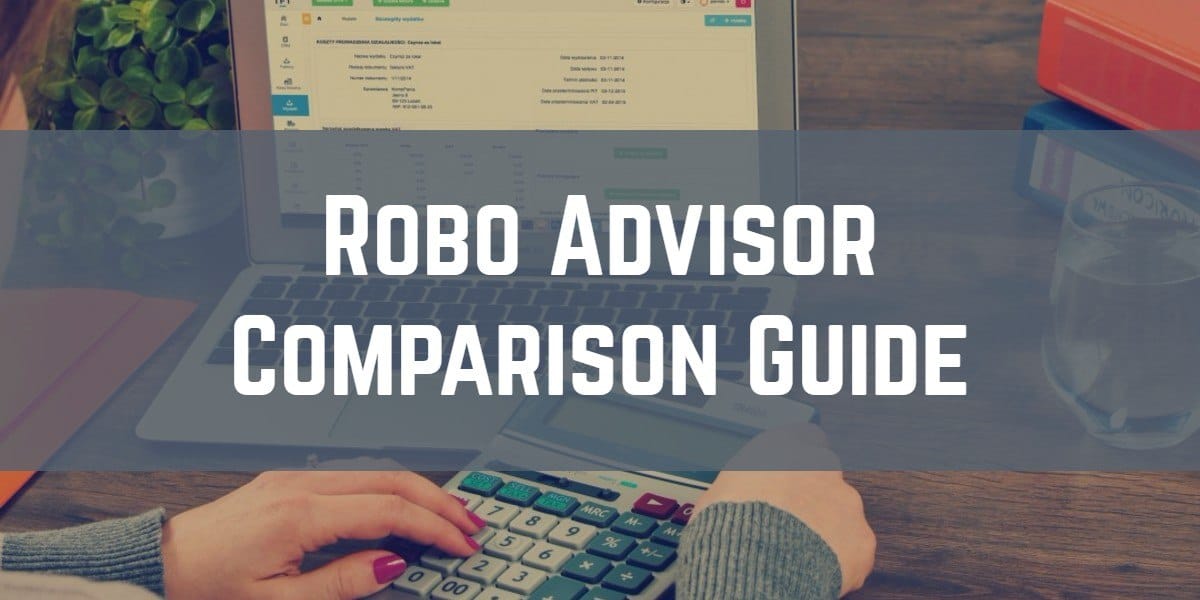Welcome to our 2024 Robo Advisor comparison guide!
Robo advisors are gaining popularity each year, not just for beginners or small investors, but for experienced and high-net-worth ones too. They provide impressive returns on investments and can be a great alternative to expensive human advisors.
We’ve analyzed, and compared the best robo advisors available in the US, so you don’t have to wade through all the options. Our guide covers the most popular and best services for most US-based investors.
So, let’s get started and find the perfect robo-advisor for you!
On This Page:
Robo Advisor Comparison Table
We’ll start with an in-depth comparison table of some of the best robo advisors on the market today. This list of robo advisors is sorted alphabetically.
| Robo Advisor | Features | Fees | Minimum Deposit | Access to Human Financial Advisors | Best for | Visit |
|---|---|---|---|---|---|---|
| Acorns | Round-up savings, Investment Education | starts at $3 /month | $5 | No | Beginner investors, students | Visit |
| Ally Invest Robo Portfolios | Automated Portfolio Management, Tax-loss harvesting | 0.30% annually | $100 | No | Investors with Ally bank accounts | Visit |
| Axos Invest | Socially responsible investing, Tax-loss harvesting | 0.24% annually | $500 | Yes | hands-off investors and self-directed traders | Visit |
| Betterment | Tax-loss harvesting, Retirement Planning, socially responsible investing, cash management | 0.25%-0.50% annually | $0 | Yes, with the premium plan | Beginner to intermediate investors, socially responsible investing | Visit |
| E-Trade Core Portfolios | Automated Portfolio Management, Tax-loss harvesting | 0.30% annually | $500 | Yes | E-Trade customers with lower balances | Visit |
| Ellevest | Gender-based investing, goal-based investing, career coaching | 0.25%-0.50% annaully | $0 | Yes, with the premium plan | Women-focused investors, goal-based investing, career coaching | Visit |
| Empower (formerly Personal Capital) | Comprehensive financial planning, retirement planning, wealth management | 0.49%-0.89% annually | $100,000 | Yes, with Wealth Management plan | High net worth investors, comprehensive financial planning | Visit |
| Fidelity Go | Retirement Planning, Cash Management | 0.35% annually | $10 | Yes, with premium plan | Fidelity customers | Visit |
| FutureAdvisor by BlackRock | Automated Portfolio Management, Tax-loss harvesting | 0.50% annually | $5000 | Yes | Investors with existing BlackRock accounts, personalized investment | Visit |
| Interactive Advisors | Automated Portfolio Management, Access to Advisors | 0.08%-0.75% annually | $100 | Yes | Investors seeking a hybrid experience | Visit |
| M1 Finance | Automated Portfolio Management, Fractional Shares | Free | $100 | No | DIY investors with long-term focus | Visit |
| Schwab Intelligent Portfolios | Automated Portfolio Management, Tax-loss harvesting | Free | $5,000 | Yes, with Premium plan | Schwab customers, hands-off investors, tax-efficient investing | Visit |
| SigFig | Automated Portfolio Management, Access to Advisors | 0.25% annually | $2,000 | Yes | Investors seeking a hybrid experience | Visit |
| SoFi Automated Investing | Automated Portfolio Management, Financial Planning | Free | $1 | Yes | Young investors with small balances | Visit |
| Stash Automated Investing | Fractional Shares, Educational content | $3-$9/month | $5 | No | Beginner investors | Visit |
| Titan Invest | Concentrated Investing, Access to Advisors | 0.5% annually | $500 | Yes | Experienced investors, actively managed investment portfolios | Visit |
| Vanguard Digital Advisor | Automated Portfolio Management, Retirement Planning | 0.20% annually | $3,000 | No | Vanguard customers, well-known and established investment firm. | Visit |
| Vanguard Personal Advisor | Personalized Portfolio Management, Retirement Planning | 0.30% annually | $50,000 | Yes | High net worth investors | Visit |
| Wealthfront | Automated Portfolio Management, Tax-loss harvesting | 0.25% annually | $500 | No | Beginner to intermediate investors, retirement planning | Visit |
| Wells Fargo Intuitive Investor | Automated Portfolio Management, Access to Advisors | 0.35% | $500 | Yes | Existing Wells Fargo customers | Visit |
Minimum Deposit Comparison
| Robo Advisor | Minimum Deposit |
|---|---|
| Acorns | $0 |
| Ally Invest Robo Portfolios | $100 |
| Axos Invest | $500 |
| Betterment | $0* |
| E-Trade Core Portfolios | $500 |
| Ellevest | $0 |
| Empower (formerly Personal Capital) | $100,000 |
| Fidelity Go | $10 |
| FutureAdvisor by BlackRock | $5,000 |
| Interactive Advisors | $100 |
| M1 Finance | $100 |
| Schwab Intelligent Portfolios | $5,000 |
| SigFig | $2,000 |
| SoFi Automated Investing | $1 |
| Stash Invest | $5 |
| Titan Invest | $500 |
| Vanguard Digital Advisor | $3,000 |
| Vanguard Personal Advisor | $50,000 |
| Wealthfront | $500 |
| Wells Fargo Intuitive Investor | $500 |
Verdict

Overall, we’d say that any robo advisor with a minimum deposit of $500 or less would be considered good for smaller, beginner investors. While many services tout a minimum of $0 or $1, you aren’t really going to see any returns on a deposit that low. Those tiny limits are there to either entice investors to sign up, or simply to test out the service before investing a larger amount.
What we call ‘medium-sized’ investors should look into Vanguard Digital Advisor or Schwab since they have a $3,000 and $5,000 minimum, respectively.
Zack’s Advantage sits at a relatively high $25,000, while Vanguard Personal Advisor is for bigger investors with more than $50,000 to invest. Empower requires a $100,000 minimum deposit for the Wealth Management service but has many free financial tools for any account size that are very much worth utilizing.
Pricing & Fees Comparison
Fees – the all-mighty decider. Of course, each robo advisor’s annual fees play a huge role in an investor’s decision to invest money with them. After all, that is one of the biggest benefits of robo advisors compared to human financial advisors – drastically reduced fees.
| Robo Advisor | Management Fee |
|---|---|
| Acorns | $3/month |
| Ally Invest Robo Portfolios | 0.30% |
| Axos Invest | 0.24% |
| Betterment | 0.25% – 0.50%* |
| E-Trade Core Portfolios | 0.30% |
| Ellevest | 0.25% – 0.50% |
| Empower (formerly Personal Capital) | 0.49% – 0.89% |
| Fidelity Go | 0.35% |
| FutureAdvisor by BlackRock | 0.50% |
| Interactive Advisors | 0.08% – 0.75% |
| M1 Finance | $0 |
| Schwab Intelligent Portfolios | $0 |
| SigFig | 0.25% |
| SoFi Automated Investing | $0 |
| Stash Invest | $3-$9/month |
| Titan Invest | 0.5% |
| Vanguard Digital Advisor | 0.20% |
| Vanguard Personal Advisor | 0.30% |
| Wealthfront | 0.25% |
| Wells Fargo Intuitive Investor | 0.35% |
Keep in mind that just because a fee is higher doesn’t mean you shouldn’t consider the service. Some robo advisors offer extra features for their fees or have a different investment strategy you might align better with. Having said that, it doesn’t mean you should invest with them either. Make sure you choose the best robo advisor for your needs. This comparison only serves as a reference.
Verdict

Based on our Robo Advisor fees comparison, it is easy to see that management fees will vary wildly depending on the service and investment amount.
In general, you can get reduced fees for both lower investment amounts (using our links), while some robo advisors lower their fees over a certain investment amount, in addition to offering advanced features and options.
If you’re dipping your toes into robo advisor water, so to speak, you can get several free services up to about $25,000, or you can go with M1 Finance or Schwab, which never cost anything at any amount. Personal Capital’s excellent Financial Tools are also entirely free.
- M1 Finance: Always free
- Schwab Intelligent Portfolios: Always free
- Wealthfront: Free under $5,000 (with our link)
- Personal Capital: Financial tools & dashboard is free
Wealthfront, Betterment, and Vanguard Digital Advisor are all good examples of affordable robo advisors that take a set-it-and-forget-it approach and are especially good for beginners or investors looking to be hands-off.
Account Features Comparison
Whether you prefer automated investing or active trading, it’s important to compare the account features of the robo advisors you’re considering investing in. Here is our comparison of the various account features that robo advisors have to offer:
| Robo Advisor | Portfolio Rebalancing | Tax Loss Harvesting | Automatic Deposits | Human Financial Advisors | Fractional Shares | Cash or Savings Account (APY) |
|---|---|---|---|---|---|---|
| Acorns | Yes | No | Yes | No | Yes | No |
| Ally Invest Robo Portfolios | Yes | Yes | Yes | Yes | Yes | Yes (4.35%) |
| Axos Invest | Yes | Yes | Yes | No | Yes | No |
| Betterment | Yes | Yes | Yes | Yes | Yes | Yes (4.75%) |
| E-Trade Core Portfolios | Yes | Yes | Yes | Yes | Yes | Yes (4.25%) |
| Ellevest | Yes | Yes | Yes | Yes | Yes | No |
| Empower (formerly Personal Capital) | Yes | Yes | Yes | Yes | Yes | Yes (4.7%) |
| Fidelity Go | Yes | Yes | Yes | No | Yes | Yes (2.72%) |
| FutureAdvisor by BlackRock | Yes | Yes | Yes | Yes | Yes | No |
| Interactive Advisors | Yes | Yes | Yes | Yes | Yes | No |
| M1 Finance | Yes | No | Yes | No | Yes | Yes (3.30%) |
| Schwab Intelligent Portfolios | Yes | Yes | Yes | No | Yes | No |
| SigFig | Yes | Yes | Yes | Yes | Yes | No |
| SoFi Automated Investing | Yes | Yes | Yes | Yes | Yes | Yes (4.60%) |
| Stash Invest | Yes | No | Yes | No | Yes | No |
| Titan Invest | Yes | No | Yes | Yes | Yes | Yes (5.28%) |
| Vanguard Digital Advisor | Yes | Yes | Yes | No | Yes | Yes (4.70%) |
| Vanguard Personal Advisor | Yes | Yes | Yes | Yes | Yes | Yes (4.70%) |
| Wealthfront | Yes | Yes | Yes | No | Yes | Yes (5.0%) |
| Wells Fargo Intuitive Investor | Yes | Yes | Yes | Yes | Yes | Yes |
We hope that our 2024 Robo Advisor Comparison Guide gives you an idea of what investing service is perfect for you. Let us know if you think we should add anything to this guide.


